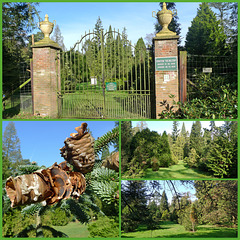
Nederland: natuur en landschap
Folder: Nederland - the Netherlands
Foto's van Nederlandse landschappen en natuur.
Voor foto's van bloembollen zie: www.ipernity.com/doc/294067/album/1303332
Voor foto's van bloembollen zie: www.ipernity.com/doc/294067/album/1303332
Nederland - Vorden, Pinetum de Belten
| |
|
|
|
Pinetum de Belten is an arboretum with only conifers. This pinetum was founded by Squire Mr. P.R Feith in 1961, when he started collecting pine-trees from all over the world.
Pinetum de Belten is grown from the start to 1400 different types of pine trees. Due to lack of space for so many trees in 1992 the decision was made at around 700 trees to be grubbed up. Sub-tropical trees are removed out of the collection.Nowadayas there are more than 1000 different kinds of trees. Species must be able to grow in this environment. A single exception is made for unique items of the collection.
Since 1974 the pinetum is managed by a foundation. The main goal is to maintain and care for the collection of pine trees. Pinetum de Belten is free to visit, although a voluntary donation is very welcome.
Nederland – Vorden, Kasteel Hackfort / Stinzenplan…
| |
|
|
|
The name 'stinzenplanten' originates from the Frisian word 'stins', which means 'stone'. That refers to the time when only rich people had a house of stone. From the 16th century onwards, adventurers took all kinds of bulbous, tuberous and root plants with them from their travels. They sold these plants to people who could afford them: owners of country estates, castles and mansions. ‘Stinzenplanten’ are very suitable for naturalization. On some estates the house has already disappeared, but the plants still bloom every spring.
On the Hackfort estate around the medieval castle have always been many stinzenplanten in the landscape park, dating back from around 1820. It is known that there were large areas of forest anemones and lilies of the valley. But more and more blackberries got the upper hand and many of the original flowers disappeared.
In 1981, Hackfort Castle and estate were donated to Natuurmonumenten (Netherlands Natural Heritage Society). In 2009 an inventory of the plants was made and a year later the society commissioned landscape-architect Trudi Woertman to make a design for an additional stinzenflora planting on Hackfort. Nowadays the park around the castle is an imposing eye-catcher with thousands of blooming springtime flowers.
Nederland - Vlieland
| |
|
|
|
A collage of flowers we came across during a cycle trip on the island of Vlieland.
Nederland - Weesp, Theetuin
| |
|
|
|
The Theetuin (Tea Garden) is situated on one of the four bastions of the old fortified town of Weesp. The bastion is called “Bakkerschans” and was built in 1674. It is surrounded by a wall on which stately, old trees are growing. This historical location, an oasis hidden in greenery, is the location of the romantic tea garden.
In 1986 it was the first tea garden in the Netherlands was established. It was designed by landscape architects and offers a beautiful model garden with special plants, pots and an attractive tea house (limited opening hours). Meanwhile, the garden has grown into a real paradise where the garden enthusiast will have a great time.
The Theetuin is well-known due to its plant combinations, mixtures of perennials, shrubs and especially spring flowering bulbs. The garden is at its best in spring, when thousands of bulbs start to flower, ranging from snow drops to late flowering tulips.
Nederland - Zwartemeer, Bargerveen
| |
|
|
|
After the last ice age - about 10 thousand years ago - the climate began to grow warmer and wetter. Sphagnum moss began to grow in the stagnant waters. The peat continued to grow and to spread. To the east of the Hondsrug - a ridge of sand that is mainly located in the Dutch province Drenthe - it developed into the enormous Bourtange peat bog, which at one time measured 3.000 square kilometres.
The layer of peat became so thick that it even began to grow up high against the sides of the Hondsrug . On the edge of the Bargerveen , the peat covered the Hondsrug completely. The Bargerveen is the only large area of the Bourtange peat bog still surviving in the Netherlands. It is now a nature reserve of more than 2.000 hectares with one of the last areas of living peat.
A peat bog is anything but flat and monotonous. The area is characterized by a wide variety of landscapes: swamp, grassland, heather, forest and water. The northern part of the Bargerveen is one large stretch of water. It is a real paradise for birdlife, as one can see from a large bird hide (PiP4).
Since 2006 the Bargerveen is part of the Internationaler Naturpark Bourtanger Moor-Bargerveen (Bourtanger Moor-Bargerveen International Nature Park), a nature reserve located on both sides of the border between the Netherlands and Germany. The Dutch part of the nature reserve was founded in 1992 as Natuurreservaat Bargerveen .
Jump to top
RSS feed- Latest items - Subscribe to the latest items added to this album
- ipernity © 2007-2024
- Help & Contact
|
Club news
|
About ipernity
|
History |
ipernity Club & Prices |
Guide of good conduct
Donate | Group guidelines | Privacy policy | Terms of use | Statutes | In memoria -
Facebook
Twitter





